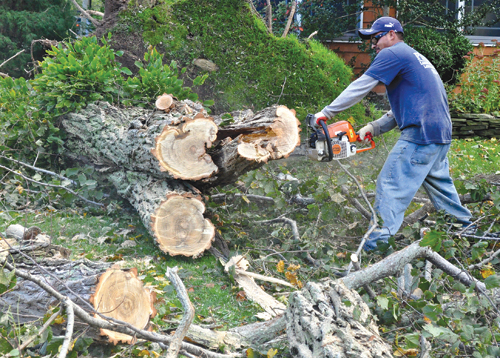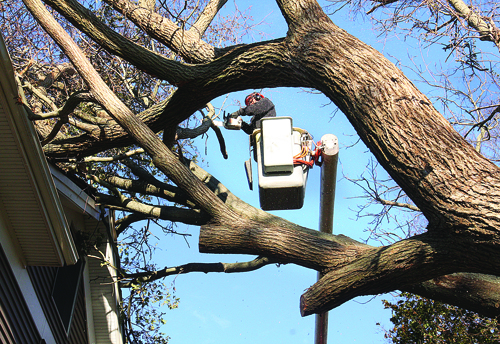Tree pros on safety: ‘Ladders and chainsaws don’t mix’

You might be tempted to remove that fallen tree from your front yard yourself this week. And some of the tiny ones are fair game.
But that giant oak resting on your rooftop? Some things you just shouldn’t try at home.
“Anything that requires a ladder should be left to professionals,” said Josh Carrick of Carrick’s Tree Service in Aquebogue. “Ladders and chain saws don’t mix.”
Mr. Carrick’s company is one of many on the North Fork with their hands full of tree limbs since Hurricane Sandy swept across the North Fork Oct. 29, as they remove trees from atop North Fork homes, cars and driveways.
By Monday Mr. Carrick’s company had removed about fifty trees throughout the Riverhead, Jamesport and Mattituck areas. “We’ve had three crews working almost non-stop since the storm,” he said.
Mr. Carrick said that in addition to trees with rotten centers, his company has seen a lot of trees downed due to poor landscaping techniques, as well as tree limbs fallen from un-pruned trees.
“Trees that are planted too deep have roots that grow straight up and ones in wire baskets that are too big for them can have their roots grow in a circle,” he said. “If the roots aren’t well-established, there’s nothing anchoring the tree down. We saw a lot of that in the storm, as well as more established trees that hadn’t been pruned regularly.”
He said trees with dense crowns, due to lack of pruning, tend to get damaged by the wind more than regularly pruned trees.
Chet Ciaglo of Peconic-based Pine Oaks Lawncare and Landscaping Inc. said his crew has also been busy clearing downed trees farther east.
“I’d say we’ve removed about two dozen already so far,” he said Friday. “There were a lot of trees down in Nassau Point, along Peconic Bay Boulevard in the Mattituck/Laurel area and in Southold, the Bayview and Cedar Beach areas, as well as by Kenney’s Beach.”
Mr. Ciaglo and Mr. Carrick said that while homeowners can certainly take it upon themselves to safely remove trees from their own lawns, trees on houses should be left to landscaping professionals.
“Sometimes you need to use a piece of heavy equipment to get trees off of houses and it may need to be tied off in a special way so it doesn’t hurt the house any more than it already has,” Mr. Ciaglo said.
He added that trees that fall on top of electrical wires should be exclusively reserved for removal by LIPA, as no landscapers are certified to remove them.
Dotty McKnight of Wading River said she returned this week from a trip down south to find that a large tree in front of her North Country Road home had fallen onto electrical wires.
While she said four tree companies had left fliers for her she was told nothing can be done until LIPA comes to clear the tree.
“We couldn’t even get through our front door,” she said.
It’s a scenario playing out all over the North Fork, but as much as residents might be tempted to take matters into their own hands, Jonathan Shipman of Shamrock Tree Expert Co. in Mattituck urges people not to.
“If a large tree falls on a smaller sapling and you cut the smaller sapling the wrong way, the tree could spring toward you,” Mr. Shipman warned. “It’s called spring pull and trees can fall on top of a person that way, knocking them unconscious or even killing them.”
He added that anything more than 14 feet off the ground should also be left to professionals.
For homeowners looking to chop up downed trees that have fallen in their yards, Mr. Shipman and Mr. Ciaglo both said extreme caution should be used when wielding a chain saw, a tool they agreed needs to be held with both hands at all times.
Mr. Ciaglo added that homeowners also need to make sure they’re cutting in front of them, instead of off to one side. To prevent possible injury, he said, chain saws should be placed in the “lock” position while running but not in active use, so the blade stops turning.
According to Mr. Shipman, another way to prevent injury is to wear proper clothing.
“You also don’t want to wear loose-fitting clothing when you’re using a chain saw,” he said. “Baggy T-shirts and pants can get sucked into the equipment and pull you into the blade.”
Both tree professionals said protection of one’s face and hands are also at the top of the list for chain saw safety.
“There are helmets out there with screen shields in the front to keep wood chips from going into your eyes,” Mr. Ciaglo said.
Mr. Shipman said in addition to face and hand protection, ear protection and “chain saw chaps” should be considered.
“Wearing chain saw chaps prevents you from cutting into your leg through your pants,” he said. “Because of the artery that runs through the femur in the leg, it’s very important for people to do that.”
Mr. Ciaglo said leather chain saw chaps can also be helpful when climbing trees in the absence of a bucket truck.








